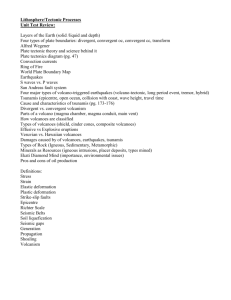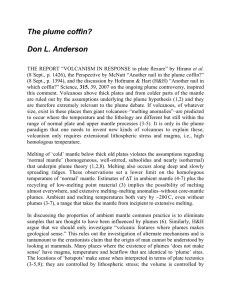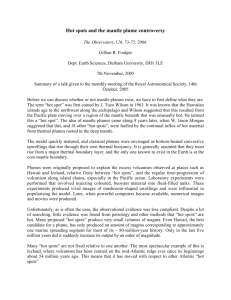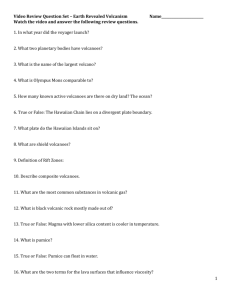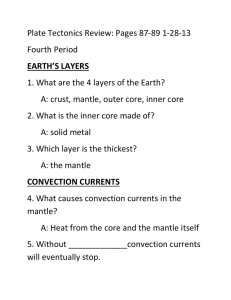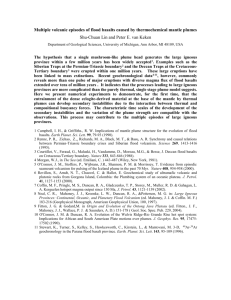43 45 52 LETTERS
advertisement
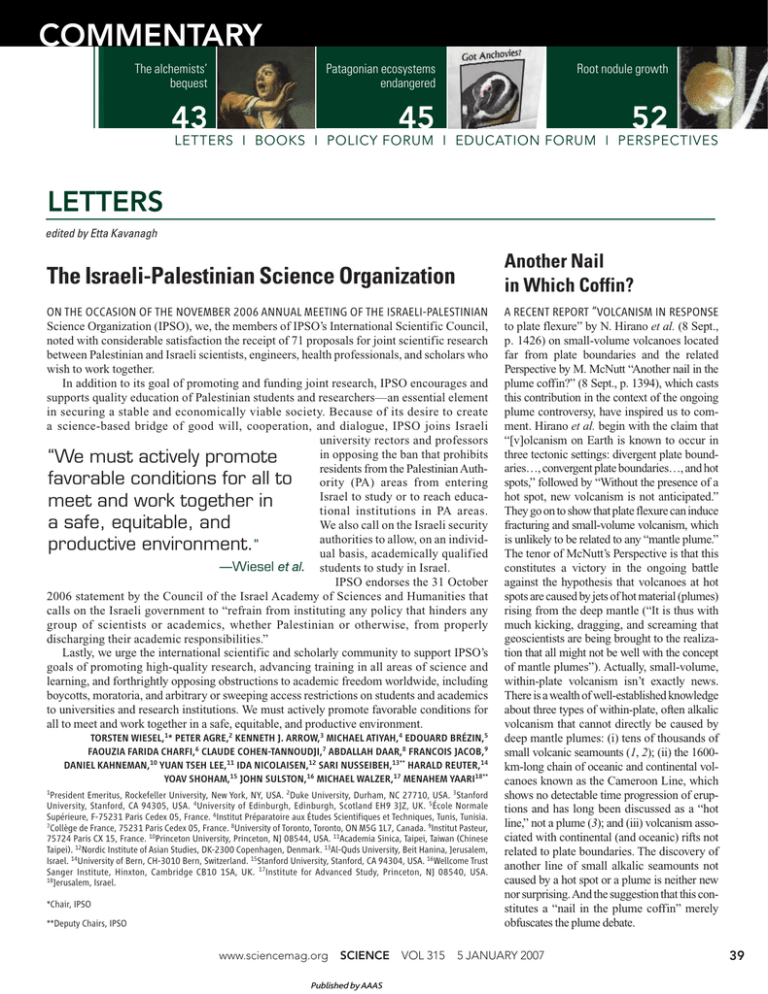
COMMENTARY The alchemists’ bequest Patagonian ecosystems endangered Root nodule growth 43 45 52 LETTERS I BOOKS I POLICY FORUM I EDUCATION FORUM I PERSPECTIVES LETTERS edited by Etta Kavanagh Another Nail in Which Coffin? The Israeli-Palestinian Science Organization ON THE OCCASION OF THE NOVEMBER 2006 ANNUAL MEETING OF THE ISRAELI-PALESTINIAN Science Organization (IPSO), we, the members of IPSO’s International Scientific Council, noted with considerable satisfaction the receipt of 71 proposals for joint scientific research between Palestinian and Israeli scientists, engineers, health professionals, and scholars who wish to work together. In addition to its goal of promoting and funding joint research, IPSO encourages and supports quality education of Palestinian students and researchers—an essential element in securing a stable and economically viable society. Because of its desire to create a science-based bridge of good will, cooperation, and dialogue, IPSO joins Israeli university rectors and professors in opposing the ban that prohibits “We must actively promote residents from the Palestinian Authfavorable conditions for all to ority (PA) areas from entering Israel to study or to reach educameet and work together in tional institutions in PA areas. a safe, equitable, and We also call on the Israeli security authorities to allow, on an individproductive environment.” ual basis, academically qualified —Wiesel et al. students to study in Israel. IPSO endorses the 31 October 2006 statement by the Council of the Israel Academy of Sciences and Humanities that calls on the Israeli government to “refrain from instituting any policy that hinders any group of scientists or academics, whether Palestinian or otherwise, from properly discharging their academic responsibilities.” Lastly, we urge the international scientific and scholarly community to support IPSO’s goals of promoting high-quality research, advancing training in all areas of science and learning, and forthrightly opposing obstructions to academic freedom worldwide, including boycotts, moratoria, and arbitrary or sweeping access restrictions on students and academics to universities and research institutions. We must actively promote favorable conditions for all to meet and work together in a safe, equitable, and productive environment. TORSTEN WIESEL,1* PETER AGRE,2 KENNETH J. ARROW,3 MICHAEL ATIYAH,4 EDOUARD BRÉZIN,5 FAOUZIA FARIDA CHARFI,6 CLAUDE COHEN-TANNOUDJI,7 ABDALLAH DAAR,8 FRANCOIS JACOB,9 DANIEL KAHNEMAN,10 YUAN TSEH LEE,11 IDA NICOLAISEN,12 SARI NUSSEIBEH,13** HARALD REUTER,14 YOAV SHOHAM,15 JOHN SULSTON,16 MICHAEL WALZER,17 MENAHEM YAARI18** 1President Emeritus, Rockefeller University, New York, NY, USA. 2Duke University, Durham, NC 27710, USA. 3Stanford University, Stanford, CA 94305, USA. 4University of Edinburgh, Edinburgh, Scotland EH9 3JZ, UK. 5École Normale Supérieure, F-75231 Paris Cedex 05, France. 6Institut Préparatoire aux Études Scientifiques et Techniques, Tunis, Tunisia. 7Collège de France, 75231 Paris Cedex 05, France. 8University of Toronto, Toronto, ON M5G 1L7, Canada. 9Institut Pasteur, 75724 Paris CX 15, France. 10Princeton University, Princeton, NJ 08544, USA. 11Academia Sinica, Taipei, Taiwan (Chinese Taipei). 12Nordic Institute of Asian Studies, DK-2300 Copenhagen, Denmark. 13Al-Quds University, Beit Hanina, Jerusalem, Israel. 14University of Bern, CH-3010 Bern, Switzerland. 15Stanford University, Stanford, CA 94304, USA. 16Wellcome Trust Sanger Institute, Hinxton, Cambridge CB10 1SA, UK. 17Institute for Advanced Study, Princeton, NJ 08540, USA. 18Jerusalem, Israel. *Chair, IPSO **Deputy Chairs, IPSO www.sciencemag.org SCIENCE Published by AAAS VOL 315 A RECENT REPORT “VOLCANISM IN RESPONSE to plate flexure” by N. Hirano et al. (8 Sept., p. 1426) on small-volume volcanoes located far from plate boundaries and the related Perspective by M. McNutt “Another nail in the plume coffin?” (8 Sept., p. 1394), which casts this contribution in the context of the ongoing plume controversy, have inspired us to comment. Hirano et al. begin with the claim that “[v]olcanism on Earth is known to occur in three tectonic settings: divergent plate boundaries…, convergent plate boundaries…, and hot spots,” followed by “Without the presence of a hot spot, new volcanism is not anticipated.” They go on to show that plate flexure can induce fracturing and small-volume volcanism, which is unlikely to be related to any “mantle plume.” The tenor of McNutt’s Perspective is that this constitutes a victory in the ongoing battle against the hypothesis that volcanoes at hot spots are caused by jets of hot material (plumes) rising from the deep mantle (“It is thus with much kicking, dragging, and screaming that geoscientists are being brought to the realization that all might not be well with the concept of mantle plumes”). Actually, small-volume, within-plate volcanism isn’t exactly news. There is a wealth of well-established knowledge about three types of within-plate, often alkalic volcanism that cannot directly be caused by deep mantle plumes: (i) tens of thousands of small volcanic seamounts (1, 2); (ii) the 1600km-long chain of oceanic and continental volcanoes known as the Cameroon Line, which shows no detectable time progression of eruptions and has long been discussed as a “hot line,” not a plume (3); and (iii) volcanism associated with continental (and oceanic) rifts not related to plate boundaries. The discovery of another line of small alkalic seamounts not caused by a hot spot or a plume is neither new nor surprising. And the suggestion that this constitutes a “nail in the plume coffin” merely obfuscates the plume debate. 5 JANUARY 2007 39 LETTERS The basic rules of geochemistry tell us that high enrichments of incompatible trace elements found in alkali basalts require low degrees of melting; such melts are hardly a surprise in regions of thick oceanic lithosphere. Whether the volcanism itself is triggered by a mantle plume or a fracture in the lithosphere is a separate question. The observation that fractures can and do trigger volcanism is not an argument against deepmantle plumes, any more than confirmation of mantle plumes, for example, through seismic tomography (4), could be an argument against fracture-related volcanism. The question of whether deep-mantle plumes exist is too important to our understanding of mantle dynamics to be addressed in this fashion. Instead, let’s look at those volcanic features where a plume mechanism actually makes some geological sense and investigate those. We suspect that geochemistry will not deliver the silver bullet for proving or disproving plumes. Rather, we suspect that when the dust has settled over the mapping of plumes with seismic tomography, we will come to a consensus over the question of whether the Hawaiian hot spot, for example, is caused by a plume. Evidence from small seamounts seems completely irrelevant to this debate. So before we nail any more coffins, let’s first be sure that there is a body to be buried. ALBRECHT W. HOFMANN1 AND STANLEY R. HART2 1Max Planck Institute for Chemistry, Postfach 3060, D55020 Mainz, Germany. E-mail: hofmann@mpchmainz.mpg.de. 2Woods Hole Oceanographic Institution, Woods Hole, MA 02543, USA. References 1. A. Zindler, H. Staudigel, R. Batiza, Earth Planet. Sci. Lett. 70, 175 (1984). 2. R. Batiza, D. Vanko, J. Geophys. Res. 89, 11235 (1984). 3. J. G. Fitton, H. M. Dunlop, Earth Planet. Sci. Lett. 72, 23 (1985). 4. R. Montelli et al., Science 303, 338 (2004). Response WE FOUND YOUNG ALKALIC VOLCANOES, NOT older than 1 million years, on the edge of 135million-year-old oceanic crust in the Northwest Pacific, where it is subducting into the Kuril and Japan trenches. These volcanoes are closely associated with the occurrence of extensional cracks in the flexed parts of the subducting Pacific Plate, allowing small amounts of partial melts to find their way to Earth’s surface from the shallow asthenosphere. Because of their small volume, we named these volcanoes petit spots, which should not be confused with hot spot volcanism. Hofmann and Hart fittingly note that McNutt’s Perspective stretches her interpretation of this new type of within-plate volcanism too thin, by linking it to the heated debate 40 on the existence of mantle plumes and the formation of the major hot spot trails, like Hawaii (1, 2). We agree with Hofmann and Hart that the discussion of the petit spot model should be divorced from the ongoing mantle plume debate. Instead, we emphasize the unique tectonic settings in which the petit spot volcanoes are formed. Other types of non–plume-related volcanism have been recognized to exist close to the midocean spreading centers, in continental rifts, and maybe in some seamount trails, like the Cameroon Line. However, none of these volcanoes were formed at locations far away from spreading centers, hot spots, or, more generally, areas of thermal upwelling. Whereas small off-axis seamounts (3–5) are easily explained by the faulting and thermal contraction of juvenile oceanic crust during seafloor spreading, the formation of young volcanoes on oceanic crust older than 100 million years is rather uncommon and remained undiscovered until we recognized the petit spots on the oldest part of the Pacific Plate. These volcanoes have geochemical signatures that are characterized by highly alkaline major element compositions, highly enriched incompatible elements, and degassed noble gas isotope ratios. These characteristics suggest a low degree of partial melting in combination with an origin in the shallow upper mantle, about 95 km deep. The petit spots thus should be accepted as a new type of within-plate volcanoes that are not fed by large-scale thermal upwellings or mantle plumes. However, it also is a rather uncommon type of volcanism, which only represents a minute fraction of the total volcanic output in the ocean basins. As Hofmann and Hart argue, this type of volcanism is entirely unrelated to the processes that may form the voluminous Hawaiian seamount trail. In fact, the petit spots can be entirely explained by the bending and cracking of the subducting Pacific Plate, which is a rather unique situation and may only be reserved for oceanic crust that is located close to a convergent plate boundary. NAOTO HIRANO AND ANTHONY A. P. KOPPERS Scripps Institution of Oceanography, University of California, San Diego, 9500 Gilman Drive, La Jolla, CA 92093–0225, USA. E-mail: nhirano@ucsd.edu; akoppers@ ucsd.edu References 1. G. R. Foulger, J. H. Natland, Science 300, 921 (2003). 2. A. A. P. Koppers, H. Staudigel, Science 307, 904 (2005). 3. A. Zindler, H. Staudigel, R. Batiza, Earth Planet. Sci. Lett. 70, 175 (1984). 4. R. Batiza, Y. Niu, W. C. Zayac, Geology 18, 1122 (1990). 5. D. T. Sandwell et al., J. Geophys. Res. 100, 15087 (1995). Response I AGREE COMPLETELY WITH HOFMANN AND Hart that a nonplume origin for young volcanoes seaward of the Japan trench cannot be used to argue that plumes do not exist anywhere. As they point out, Earth is rife with examples of nonplume volcanoes that form along suspected fractures away from plate boundaries. What is unusual in this particular case is that, in addition to the fracturing mechanism being well constrained rather than just “surmised,” small volumes of melt penetrated a very thick plate above a region of large-scale downwelling, all features that are the antithesis of what is expected from plume theory. The existence or nonexistence of plume-type transport of heat and mass bears on the rheology of Earth’s mantle, thermal and chemical layering in the interior, mixing rates of geochemical heterogeneities, the energy budget of the geodynamo, and other properties that are difficult to assess deep within this dynamic planet. Indeed, high-resolution seismic imaging holds the best hope for settling this debate. However, further gains in resolution at the scale needed to resolve plumes require filling in the very large gaps in network coverage in the ocean basins with seismic receivers, one of the goals of the Ocean Observatories Initiatives of the U.S. National Science Foundation. Recently, concerns over the cost of installing and maintaining deep-water open-ocean seismic observatories have led to a reduction in the plans for filling in these gaps. Sadly, unless some new source of funding or more affordable technology can be found, 10 years from now, our “patient” might still be lying on life support. MARCIA MCNUTT Monterey Bay Aquarium Research Institute, 7700 Sandholdt Road, Moss Landing, CA 95039, USA. E-mail: mcnutt@mbari.org Letters to the Editor Letters (~300 words) discuss material published in Science in the previous 6 months or issues of general interest. They can be submitted through the Web (www.submit2science.org) or by regular mail (1200 New York Ave., NW, Washington, DC 20005, USA). Letters are not acknowledged upon receipt, nor are authors generally consulted before publication. Whether published in full or in part, letters are subject to editing for clarity and space. 5 JANUARY 2007 VOL 315 SCIENCE Published by AAAS Chemistry Nobel Rich in Structure THE 2006 NOBEL PRIZE IN CHEMISTRY, awarded to Roger Kornberg for the structure and understanding of RNA polymerase (“Solo winner detailed path from DNA to RNA,” www.sciencemag.org
